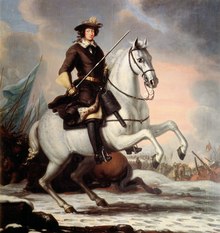Charles XI. (Sweden)

Charles XI. (* 24 November July / 4 December 1655 greg. In Stockholm ; † 5 April July / 15 April 1697 greg. Ibid) from the noble family of Wittelsbach was King of Sweden from 1660 to 1697 , in personal union from 1681 until 1697 as Karl I. also Duke of Pfalz-Zweibrücken and as Karl XI. from 1660 to 1697 Duke of the Duchy of Bremen-Verden .
Life
Charles XI. was the son of Karl X. Gustav of Sweden and his wife Hedwig of Schleswig-Holstein-Gottorp . He inherited the royal crown at the age of five. Since he was still a minor, his mother and five top state officials were in power. The poorly coordinated budget management at this time led to an acute shortage of money in the Swedish state, which was also felt after Karl took over the government on July 18 . / December 28, 1672 greg. changed nothing decisive. The young king mainly let his Chancellor, Magnus Gabriel de la Gardie , take care of the unpopular affairs of state. That is why he was the most powerful man in Sweden for several years.
De la Gardie had also made a pact of assistance with the French king, Louis XIV . When Louis XIV in 1672 in. Dutch War in Holland remembered the mutual assistance pact came into force. Sweden sent an army that was allied with Holland to Brandenburg , thus unleashing the Swedish-Brandenburg War . In the battle of Fehrbellin on 18 jul. / June 28, 1675 greg. showed how badly the Swedish military system had deteriorated and several states saw opportunities for direct attack. Charles XI. now had his Chancellor deposed and controlled the defense himself against the new enemies, which consisted of Denmark , Holland and the Holy Roman Empire .
The defense on land was successful, but the Swedish fleet steered from one defeat to the next, which briefly threatened Swedish supremacy in the Baltic Sea region . The French successes elsewhere led to the peace treaties of Nijmegen and Saint-Germain, which were favorable for Sweden, in 1679 . Sweden was able to recover in such a short time. Domestically, Charles XI. its time has come. He had the previous power structure changed in his favor and was the unrestricted ruler from 1680 until his death.
During this time, the debt was greatly reduced and the armed forces trained. After the devastating war, the Swedish fleet had to be created from scratch and when Charles died it consisted of 38 warships, 2,648 cannons and 11,000 men. The reform of the Swedish legal system, which had been planned since the beginning of the century, proceeded swiftly with the introduction of a legal commission and finally resulted in the new law of 1734. In terms of foreign policy, Sweden remained neutral or took part in alliances such as the great Vienna alliance , since it had such a bad experience with France.
Charles XI. died after a long illness on April 5, 1697 in Stockholm. He is buried in Riddarholm Church in Stockholm. Since 1680 he was married to Ulrike Eleonore of Denmark and Norway , with whom he had the following children:
- Hedwig Sophia of Sweden (born June 26, 1681 - † December 22, 1708) ∞ Friedrich IV , Duke of Schleswig-Holstein-Gottorp
- Charles XII. (June 27, 1682 - December 11, 1718), King of Sweden
- Gustav (June 14, 1683 - April 16, 1685), Prince of Sweden
- Ulrik (July 22, 1684 - April 30, 1685), Prince of Sweden
- Frederik (September 27, 1685 - October 12, 1685), Prince of Sweden
- Karl Gustav (December 17, 1686 - February 4, 1687), Prince of Sweden
- Ulrika Eleonore (February 2, 1688 - December 5, 1741), Queen of Sweden ∞ Friedrich , Landgrave of Hesse-Kassel, King of Sweden
ancestors
| Johann I of Pfalz-Zweibrücken (1550–1604) | |||||||||||||
| Johann Kasimir von Pfalz-Zweibrücken-Kleeburg (1589–1652) | |||||||||||||
| Magdalena von Jülich-Kleve-Berg (1553–1633) | |||||||||||||
| Charles X. Gustav King of Sweden (1622–1660) | |||||||||||||
| Charles IX King of Sweden (1550-1611) | |||||||||||||
| Katharina Wasa of Sweden (1584–1638) | |||||||||||||
| Anna Maria of the Palatinate (1561–1589) | |||||||||||||
| Charles XI. King of Sweden | |||||||||||||
| Johann Adolf of Schleswig-Holstein-Gottorf (1575–1616) | |||||||||||||
| Friedrich III. of Schleswig-Holstein-Gottorf (1597–1659) | |||||||||||||
| Augusta of Denmark (1580-1639) | |||||||||||||
| Hedwig Eleonora of Schleswig-Holstein-Gottorf (1636-1715) | |||||||||||||
| Johann Georg I Elector of Saxony (1585–1656) | |||||||||||||
| Maria Elisabeth of Saxony (1610–1684) | |||||||||||||
| Magdalena Sibylle of Prussia (1586–1659) | |||||||||||||
literature
- Hans Ulrich Bächtold: Karl XI. In: Biographisch-Bibliographisches Kirchenlexikon (BBKL). Volume 17, Bautz, Herzberg 2000, ISBN 3-88309-080-8 , Sp. 764-766.
- Göran Rystad: Charles XI. En biografi. Lund 2001.
Web links
- Literature by and about Karl XI. in the catalog of the German National Library
- Publications by and about Charles XI. in VD 17 .
- Illustration from 1729: Serenissimus Potentißimus Princeps ac Dominus, Dominus Carolus Suecorum, Gothorum, Vandalorumque Rex ... ( digitized version )
| predecessor | Office | successor |
|---|---|---|
| Charles X. Gustav |
King of Sweden, Duke of Bremen-Verden 1660–1697 |
Charles XII./II./II. |
| Friedrich Ludwig |
Duke of Pfalz-Zweibrücken 1681–1697 |
Charles XII./II./II. |
| Leopold Ludwig |
Duke of Pfalz-Veldenz 1694–1697 |
Charles XII./II./II. |
| personal data | |
|---|---|
| SURNAME | Charles XI. |
| BRIEF DESCRIPTION | King of Sweden and Duke of Pfalz-Zweibrücken |
| DATE OF BIRTH | 4th December 1655 |
| PLACE OF BIRTH | Stockholm |
| DATE OF DEATH | April 15, 1697 |
| Place of death | Stockholm |


